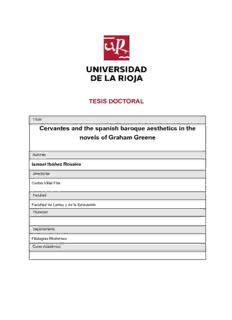Table Of ContentTESIS DOCTORAL
Título
Cervantes and the spanish baroque aesthetics in the
novels of Graham Greene
Autor/es
Ismael Ibáñez Rosales
Director/es
Carlos Villar Flor
Facultad
Facultad de Letras y de la Educación
Titulación
Departamento
Filologías Modernas
Curso Académico
Cervantes and the spanish baroque aesthetics in the novels of Graham Greene,
tesis doctoral
de Ismael Ibáñez Rosales, dirigida por Carlos Villar Flor (publicada por la Universidad de
La Rioja), se difunde bajo una Licencia
Creative Commons Reconocimiento-NoComercial-SinObraDerivada 3.0 Unported.
Permisos que vayan más allá de lo cubierto por esta licencia pueden solicitarse a los
titulares del copyright.
© El autor
© Universidad de La Rioja, Servicio de Publicaciones, 2016
publicaciones.unirioja.es
E-mail: [email protected]
CERVANTES AND THE SPANISH
BAROQUE AESTHETICS IN THE
NOVELS OF GRAHAM GREENE
By
Ismael Ibáñez Rosales
Supervised by
Carlos Villar Flor Ph.D
A thesis submitted in fulfilment
of the requirements for the degree of
Doctor of Philosophy
At
University of La Rioja, Spain.
2015
Ibáñez-Rosales
2
Ibáñez-Rosales
CONTENTS
Abbreviations ………………………………………………………………………….......5
INTRODUCTION ...…………………………………………………………...….7
METHODOLOGY AND STRUCTURE………………………………….……..12
STATE OF THE ART ..……….………………………………………………...31
PART I: SPAIN, CATHOLICISM AND THE ORIGIN OF THE
MODERN (CATHOLIC) NOVEL………………………………………38
I.1 A CATHOLIC NOVEL?......................................................................39
I.2 ENGLISH CATHOLICISM………………………………………….58
I.3 THE ORIGIN OF THE MODERN NOVEL........................................71
I.4 FROM LA MANCHA TO THULE... AND BACK.............................91
I.5 FROM CATHOLIC CERVANTES TO PROTESTANT DEFOE ....119
I.6 CATHOLIC IMAGINATION AND BAROQUE AESTHETICS….134
I.7 CATHOLIC AESTHETICS IN CERVANTES'S NOVELS..............152
I.8 MODERN RECEPTION OF CATHOLIC AESTHETICS…............190
PART II: BAROQUE AESTHETICS AND THE INFLUENCE OF SPANISH
CATHOLIC IMAGINATION IN GREENE’S NOVELS……………...222
II.1 GRAHAM GREENE'S UNFINISHED CONVERSION..................223
3
Ibáñez-Rosales
II.2 THE PATTERN IN THE CARPET..................................................245
- THE MAN WITHIN AND THE NAME OF ACTION………………...249
- ENGLAND MADE ME………………………………………….…..261
- A GUN FOR SALE………………………………………………….279
- BRIGHTON ROCK……………………………………………….…300
- THE HEART OF THE MATTER………………...……………….…321
- A BURNT-OUT CASE……………………...……………………….338
II.3 SPAIN IN GREENE ..………………………………………….…..352
- RUMOUR AT NIGHTFALL……………………………………...…358
- THE CONFIDENTIAL AGENT………………………………………....366
- THE POWER AND THE GLORY………...…………………………392
II.4 GREENE IN SPAIN………………………………………………..409
- MONSIGNOR QUIXOTE……………………...……………………420
CONCLUSIONS .................................................................................................455
BIBLIOGRAPHY................................................................................................478
APPENDIX .........................................................................................................519
4
Ibáñez-Rosales
ABBREVIATIONS
All references to quotations from works by Miguel de Cervantes and Graham
Greene appear parenthetically in the text.
- Miguel de Cervantes:
PS Los Trabajos de Persiles y Sigismunda
DQ Don Quijote de La Mancha
- Graham Greene:
B It’s a Battlefield
BC A Burnt-Out Case
BR Brighton Rock
CA The Confidential Agent
CE Collected Essays
EA The End of the Affair
EMM England Made Me
GS A Gun for Sale
HM The Heart of the Matter
JWM Journey Without Maps
LR The Lawless Roads
5
Ibáñez-Rosales
MQ Monsignor Quixote
MW The Man Within
NA Name of Action
PG The Power and the Glory
RN Rumour at Nightfall
SL A Sort of Life
ST Stamboul Train
YE Yours Etc. Letters to the Press
WE Ways of Escape
6
Ibáñez-Rosales
INTRODUCTION
Peter Ackroyd, in his 2002 Albion: The Origins of the English
Imagination, opens chapter 17 with a suggestive and revelatory title: “Faith of
Our Fathers”. The author begins with Thomas Malory’s words in his “Tale of the
Sankgreal”, where Sir Galahad witnesses the miracle of transubstantiation during
the holy communion of the Catholic Mass.
The bishop took up a wafer “which was made in lyknesse of brede. And at
the lyfftyng up there cam a figure in lyknesse of a chylde, and the visage
was as rede and as bright os ony fyre, and smote hymselff into the brede,
that all they saw hit that the brede was fourmed of a fleyshely man. And
then he put hit into the holy vessel agayne”. (Ackroyd, 2002, 123)
Ackroyd comments on the strangeness of the scene, where the wafer of
bread is transformed into a child and a man before being dipped into the chalice.
However, the image is perfectly consistent with the Catholic imagination of
Malory’s contemporaries that in the mysterious miracle of the mass the Word
does indeed become flesh. That imagination, as Ackroyd states, is at the heart of
Catholic England, at the centre of the culture which Catholic England manifested.
England was at the centre of Catholic Europe, rivalled with the Catholic European
South, and breathed in Catholic culture before the Reformation “extirpated [it] in
7
Ibáñez-Rosales
the early sixteenth century” (245). Consequently, Ackroyd wonders “whether the
legacy of the last five hundred years will outweigh or outlast a previous tradition
of fifteen hundred years” (123). The location by Ackroyd of English cultural
identity in the Catholic civilisation before the Reformation provides him with a
cultural logic both tenable and productive, certainly one that creates a new frame
of reference for the understanding of a set of dominants in English art forms.
It was a shared civilisation of ceremony and spectacle, of drama, of ritual
and display; life was only the beginning, not the end, of existence and thus
could be celebrated or scorned as one station along the holy way. It was a
world in which irony and parody of all kinds flourished, where
excremental truth and holy vision were considered fundamentally
compatible, where Aquinas could mount towards heaven with his divine
dialectic and Rabelais stoop towards the earth with his gargantuan
corporeality. It was a world of symbolic ceremony, with the processions of
Palm Sunday, the rending of the veil in Holy Week and the washing of the
feet on Maundy Thursday. Doves were released at Pentecost in St. Paul’s
Cathedral, and the Resurrection dramatised on Easter Day in Lichfield
Cathedral. (Ackroyd, 2002, 124)
Catholic rituals, especially the mass, did after all mould theatrical
representation in incontestable measures, and the centrality of theatrical traditions
in the shaping of English character cannot be overstated. In its celebratory and
ritualistic practice, Catholicism is the true kindred spirit of the English, Ackroyd
argues, because it inculcates in the individual the inclination for spectacle and
8
Description:5. ABBREVIATIONS. All references to quotations from works by Miguel de Cervantes and Graham Flannery O'Connor explains this challenge:.

